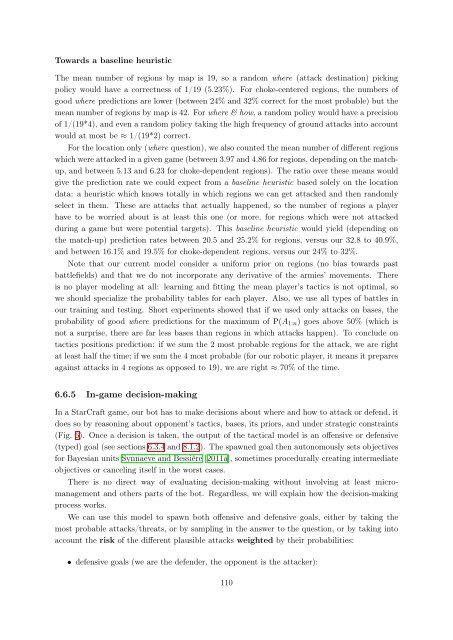Bayesian Programming and Learning for Multi-Player Video Games ...
Bayesian Programming and Learning for Multi-Player Video Games ...
Bayesian Programming and Learning for Multi-Player Video Games ...
You also want an ePaper? Increase the reach of your titles
YUMPU automatically turns print PDFs into web optimized ePapers that Google loves.
Towards a baseline heuristic<br />
The mean number of regions by map is 19, so a r<strong>and</strong>om where (attack destination) picking<br />
policy would have a correctness of 1/19 (5.23%). For choke-centered regions, the numbers of<br />
good where predictions are lower (between 24% <strong>and</strong> 32% correct <strong>for</strong> the most probable) but the<br />
mean number of regions by map is 42. For where & how, a r<strong>and</strong>om policy would have a precision<br />
of 1/(19*4), <strong>and</strong> even a r<strong>and</strong>om policy taking the high frequency of ground attacks into account<br />
would at most be ≈ 1/(19*2) correct.<br />
For the location only (where question), we also counted the mean number of different regions<br />
which were attacked in a given game (between 3.97 <strong>and</strong> 4.86 <strong>for</strong> regions, depending on the matchup,<br />
<strong>and</strong> between 5.13 <strong>and</strong> 6.23 <strong>for</strong> choke-dependent regions). The ratio over these means would<br />
give the prediction rate we could expect from a baseline heuristic based solely on the location<br />
data: a heuristic which knows totally in which regions we can get attacked <strong>and</strong> then r<strong>and</strong>omly<br />
select in them. These are attacks that actually happened, so the number of regions a player<br />
have to be worried about is at least this one (or more, <strong>for</strong> regions which were not attacked<br />
during a game but were potential targets). This baseline heuristic would yield (depending on<br />
the match-up) prediction rates between 20.5 <strong>and</strong> 25.2% <strong>for</strong> regions, versus our 32.8 to 40.9%,<br />
<strong>and</strong> between 16.1% <strong>and</strong> 19.5% <strong>for</strong> choke-dependent regions, versus our 24% to 32%.<br />
Note that our current model consider a uni<strong>for</strong>m prior on regions (no bias towards past<br />
battlefields) <strong>and</strong> that we do not incorporate any derivative of the armies’ movements. There<br />
is no player modeling at all: learning <strong>and</strong> fitting the mean player’s tactics is not optimal, so<br />
we should specialize the probability tables <strong>for</strong> each player. Also, we use all types of battles in<br />
our training <strong>and</strong> testing. Short experiments showed that if we used only attacks on bases, the<br />
probability of good where predictions <strong>for</strong> the maximum of P(A1:n) goes above 50% (which is<br />
not a surprise, there are far less bases than regions in which attacks happen). To conclude on<br />
tactics positions prediction: if we sum the 2 most probable regions <strong>for</strong> the attack, we are right<br />
at least half the time; if we sum the 4 most probable (<strong>for</strong> our robotic player, it means it prepares<br />
against attacks in 4 regions as opposed to 19), we are right ≈ 70% of the time.<br />
6.6.5 In-game decision-making<br />
In a StarCraft game, our bot has to make decisions about where <strong>and</strong> how to attack or defend, it<br />
does so by reasoning about opponent’s tactics, bases, its priors, <strong>and</strong> under strategic constraints<br />
(Fig. 6). Once a decision is taken, the output of the tactical model is an offensive or defensive<br />
(typed) goal (see sections 6.3.4 <strong>and</strong> 8.1.2). The spawned goal then autonomously sets objectives<br />
<strong>for</strong> <strong>Bayesian</strong> units Synnaeve <strong>and</strong> Bessière [2011a], sometimes procedurally creating intermediate<br />
objectives or canceling itself in the worst cases.<br />
There is no direct way of evaluating decision-making without involving at least micromanagement<br />
<strong>and</strong> others parts of the bot. Regardless, we will explain how the decision-making<br />
process works.<br />
We can use this model to spawn both offensive <strong>and</strong> defensive goals, either by taking the<br />
most probable attacks/threats, or by sampling in the answer to the question, or by taking into<br />
account the risk of the different plausible attacks weighted by their probabilities:<br />
• defensive goals (we are the defender, the opponent is the attacker):<br />
110


